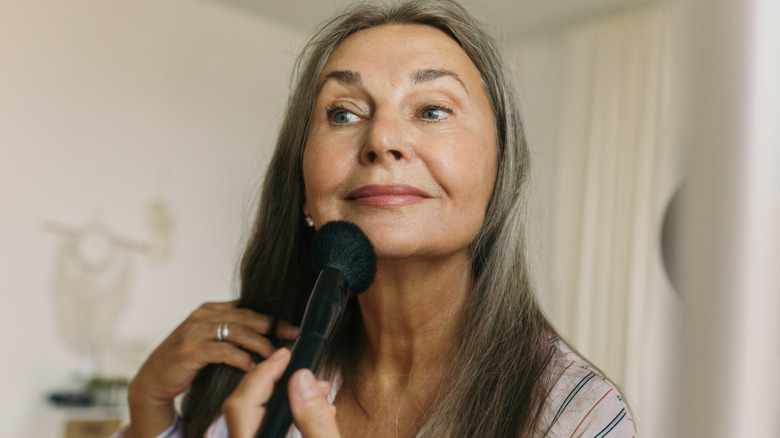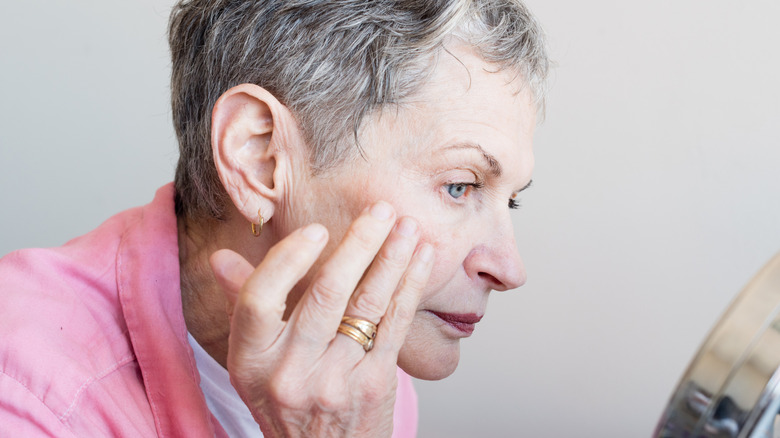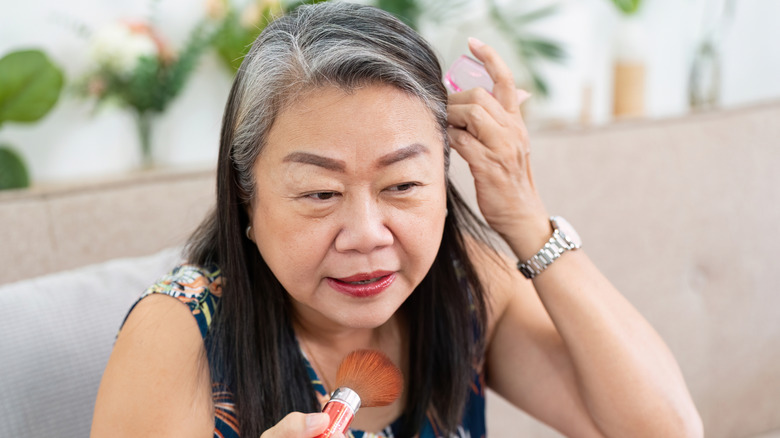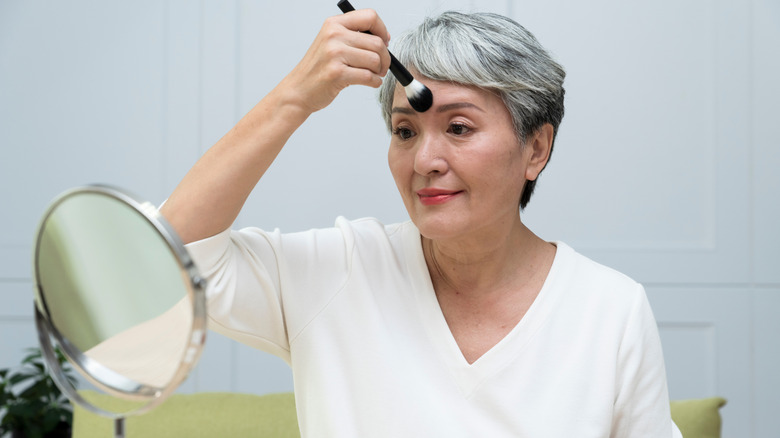The Best Tips For Applying Makeup To Mature Skin For A Flawless Finish
We may receive a commission on purchases made from links.
It doesn't matter the steps you take to prevent your skin from maturing; it's going to happen. Even if you're diligent in your skincare routine, once you hit 25, your skin's collagen levels start to naturally decrease by 1% every year. According to the American Academy of Dermatology Association, during the first five years of menopause, collagen starts to really deplete, resulting in about a 30% loss of it, and in the next 20 years that follow, it will continue to decrease by as much as 2% a year.
"The collagen present in our skin is the result of a balance between synthesis and degradation," pharmacist and head of scientific projects at L'Oréal Dermatological Beauty Spain, Mercedes Abarquero Cerezo, told Vogue in April 2025. "With the passage of time, the cells in charge of collagen synthesis reduce their activity. Plus, environmental factors like the sun, lifestyle factors like diet or stress, as well as hormone changes, accelerate its degradation." In other words, the skin you have today won't be the same skin you'll have even five years from now, meaning you not only need to adjust your skincare routine to cater to mature skin, but also change how you apply makeup.
Because everyone deserves a flawless finish, regardless of age, Women exclusively spoke with makeup artist and LA-based male groomer, Caroline Hernandez, about the best techniques for making this happen with mature skin. Getting older is a privilege. It's not something that should stand in the way of staying chic in your 60s and beyond, so it definitely shouldn't be a deterrent in having an impeccable face of makeup that literally slays.
Keep in mind that less is always more when dealing with mature skin
Because mature skin has wrinkles and fine lines, it's all about easing up on the products you use. For example, heavy matte formulas are going to find their way into those well-earned creases and emphasize them, so it's important to know what to look for in a foundation if you have mature skin (lightweight formulas are definitely on the list). After all, you want your skin to shine like it always has, and a few wrinkles shouldn't stand in the way of that.
"Drier, heavier, or more matte formulas can make our skin look duller and more textured than when we were young," Carolina Hernandez tells Women, adding that this is one of the most common mistakes people with mature skin make. Because of this, when you do reach for a lightweight foundation, you want it to be hydrating, so liquid or serum-based is the way to go. As Hernandez explains, you also want the foundation to have a luminous finish, to create a radiant look that plays with the light that hits it. Lastly, make sure your foundation has SPF.
"A couple of the foundations I love are the Ciele Skin Tint and Protect SPF 50+ and Shiseido Revitalessence Skin Glow Foundation SPF 30," says Hernandez. If you need products that are more budget-friendly, Clinique Moisture Surge Sheertint Hydrator is another option. There's also L'Oreal Paris Lumi Le Glow Skin Tint that's even easier on the wallet. Ultimately, you want to use whatever hydrating and lightweight formula is best for you, your lifestyle, and your bank account.
Don't feel the need to apply foundation to your entire face
If you're someone who, in your younger days, did a full face of foundation, it's time to break that habit. Not just because you don't need it, but because it's only going to emphasize wrinkles and fine lines. So when you do apply your hydrating, lightweight, serum-based foundation with its stunning reflective finish, Caroline Hernandez stresses that you should apply it thinly and only where it's needed.
It's also now that, if you didn't have tools before, you want to invest in them instead of just relying on your fingers. Your hands may have been able to flawlessly apply foundation when you were 30, but mature skin requires different techniques. "Press in the foundation with a damp sponge or blend it out with a foundation brush," says Hernandez, exclusively. These two tools will give you more control over the application, so you can avoid any sort of cakiness. Of all the foundation mistakes that make you look older, cakey application is definitely one of them.
Skip going overboard with under-eye makeup
Similar to your foundation application, you also want to be wary of how you're applying makeup around your eyes, especially under the eyes. Although a 2015 study published in the Aesthetic Surgery Journal found that the thinnest skin on the body is the eyelid, that space right under the eye isn't too far behind. "Your under-eyes don't have many oil glands and collagen, which makes [them] prone to dryness, fine lines, and early signs of aging," cosmetic dermatologist Michele Green told the R+F Source. It's with this in mind that you don't want to go overboard with any type of makeup under the eyes, including eye makeup like eyeliner.
"Avoid heavy products under the eyes," Caroline Hernandez exclusively tells Women. "This is also aging, and the product can gather in lines and emphasize, rather than flatter." Hernandez suggests using the most minimal of products, as well as hydrating concealer, when it comes to tackling the darkest areas. "Ciele conceal & PROTECT SPF 50+ works really well on all skin types, tones, and ages," says Hernandez. It's also worth noting that if you're someone who can't live without eye makeup, to avoid making a mistake before applying eyeliner to older eyes, it's important to clean and thoroughly hydrate the area first. This goes for both the upper and lower lids.
Make color corrector part of your life
With age comes skin discoloration. Whether it's because you were late to the party on making SPF part of your life, even during the winter months, a few years of unhealthy habits, hormonal changes, or it's simply genetics, pigment irregularities are very common in mature skin. While there are options like prescription-strength retinol or hydroquinone creams and laser treatments, if that's not the route you want to take or you don't have enough patches of discoloration for these things to be worth it, then that's where color corrector comes into play.
"If you need more coverage than a concealer alone, use a color corrector on the discolored skin only to avoid applying more makeup than needed," Caroline Hernandez exclusively tells Women. "I love the color correctors from the MAC palette, but warm up your fingers before applying this one." Hernandez is also a fan of the Charlotte Tilbury Magic Vanish. "Use a small, firm brush, and a creamy, pigmented product, and take the small brush and apply the product only where needed to keep the product only on the area of concern," says Hernandez, adding that a gentle tap with the fingers will lead to a natural finish.
Only use finishing powder on your T-zone
As your makeup routine comes to a close and you're ready to apply finishing powder, again, you want to stick to the less-is-more theory. This means refraining from covering your whole face in it powder, and only applying it where necessary. While finishing powder may not be as heavy as foundation, it can still work its way into wrinkles and draw in unwanted attention.
"Once the base is complete, finish by using a soft brush for a very light dusting of face powder, without adding weight," says Caroline Hernandez. "Only lightly set the T-zone, if needed, and very sparingly to avoid light bouncing off texture." To set the areas that you used concealer for, just add a small amount of finishing powder to complete your look and give you the flawless finish you want.
For pressed powder, Hernandez suggests Westmore Beauty 3-in-1 Photo Finishing Powder. If you're more of a loose powder person, then Iconic London Velvet Blur Translucent Setting Powder is another of her favorites. There's also, of course, setting sprays if that's more up your alley. However, no matter which you prefer, setting your face is necessary in locking everything into place and giving your makeup longevity to tackle the day and night.





